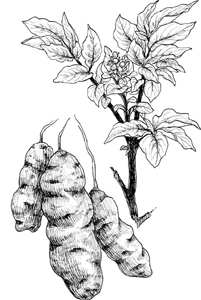
BOTANICAL NAME: Solanum ajanhuiri
FAMILY: Solanaceae

The great French horticulturist Désiré Bois was not enamored of Négresse; indeed back in 1928 he called it mediocre and worthy of the kitchen garden only as a curiosity. I suppose he was taken aback by the jet-black skin and the inky juice that drips from the potato when it is sliced raw. It is not your typical potato to say the least, and it belongs to an entirely different species: ajanhuiri. In fact, it is a wild relative of the potato more or less brought under cultivation and maintained in its unimproved state ever since it was introduced into France from Peru in about 1815. The secret to appreciating Négresse and its true culinary merits lies in understanding its strengths.
I am sure that if Bois were living today, he would be quite surprised by the attention that this unusual potato receives from trendy Paris chefs and foodies in general. This fact struck home when I walked into the Macknade Farm Shop near Faversham in Kent, England, some time ago and discovered a great heap of Négresse for sale under the name Truffle potato. Négresse is a potato with many synonyms: Vitelotte Noir, Lila Susanne, and Truffe de Chine to name just three. But it is the link with truffles that points to its culinary value, for this is indeed a potato that tastes like a truffle. It can be steamed so that it holds its deep blue-black color inside, but no matter how it is cooked its nutty taste comes through. It is the cheapest truffle I know of and one of the easiest to grow.
The plants themselves are also quite ornamental. They grow about twenty-two inches tall on dark black-brown stems. The young leaves are tinged with black; the flowers by contrast are clear, snowy white. The leaves are closer in shape to those of an ash tree than to more common potatoes, so the entire plant stands out no matter where it is situated in the garden. Only the black potato called Congo, which has sky-blue flowers, cuts a similar figure among the vegetables, but poor Congo has bitter skin and cannot compete with Négresse for blue-ribbon flavor.